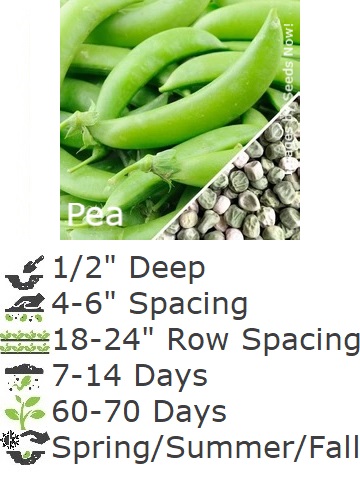
Overview
Peas tend to be a cool-weather vegetable and do best in climates where there are at least two months of cool growing weather. Consider planting in early Spring or the early Fall. Cool-weather, frost, and light freezing are three issues peas don’t fear.
Pea seeds tend to come in either smooth or wrinkled varieties. The smooth-variety is more resistant to rot in cold and damp conditions. Meanwhile, the wrinkled-variety is sweeter and flavourful, and most have been treated with a mild fungicide to prevent rot.
Plan to plant at least 25-60 plants per person depending on how much you intend to use over the winter by freezing, drying, or canning. Keep in mind that climbing and pole varieties produce over a long period and up to 5x more than a dwarf bush.
When to Plant
Plant your peas as soon as possible in early Spring. DO NOT plant in the hot summer months as your plants will not thrive, and you will have a disappointing crop. Where the winters tend to be milder, you can plant a second crop in late Summer. The best way to prolong your harvesting season is to seed early, mid, and late-season varieties at once instead of every two weeks like most vegetables.
How to Plant
If planting dwarf seeds, plant them about every 1 1/2″ and 1/2-1″ deep. Taller growing varieties should be planted in double rows approximately 2 1/2′ apart. Don’t forget to place your supports for the climbing vines in at planting time or shortly after germination but no later than 3″ tall. Peas can cross-pollinate, so if you hope to save seeds, don’t plant different varieties within 150′.
Peas have fragile roots and don’t transplant well. Some gardeners favour presoaking seeds, but research shows presoaked legume seeds absorb water too quickly, split their outer coating, spill out essential nutrients and encourage seed rot. Yields can increase by 50-100% by inoculating with Rhizobium bacteria.
How to Harvest
Peas are usually ready to harvest in just over two months. When the pods appear to swell with rounded seeds inside, it’s time to pick. When it’s getting close, take a test picking every day or so and take notice of the pods that are the sweetest. Peas that are left on the vine too long tend to be tough and starchy. Pick the pods just before you intend to use or consume them as they tend to deteriorate quickly after harvest. Pick on either a cool morning or after a cooling rain. DO NOT harvest in the heat of the day. Edible pods should be collected when the pods are grown but before they become swollen with mature peas.
Peas tend to develop from the bottom of the vine up. Be sure to hold the vine while you pull on the pods gently but firmly and pull all ripe pods off a vine to encourage more pods to be produced, or risk the plant stop developing. You will have approximately two weeks of harvesting once the process begins. Once the harvest is complete, turn the residuals of the plant to improve the soil.
Click Here to Return to the Main Page
